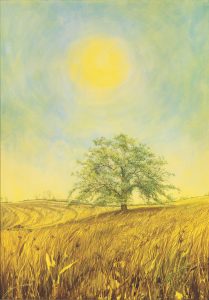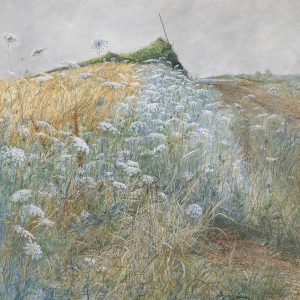Big Bend’s Prior Owner — Frolic Weymouth
Editorial assistance from Audrey Lewis, Associate Curator, Brandywine Musuem of ArtThis month's featured home had a famous owner.

The current owner of Big Bend, Mac Weymouth, shared with our writer that “Art anchors this house.” Weymouth’s home displays several of his father’s artworks, along with pieces by other artists that grace the walls. But there’s pride of place given to work by Frolic Weymouth, including a locally known painting highlighting the home and titled The Way Back.
Some background: George A. “Frolic” Weymouth (1936–2016) was perhaps best known for his philanthropic work, in particular as a founder and longtime chairman of the Brandywine Conservancy & Museum of Art. He was also a remarkable artist.
Much like his friend and artistic mentor Andrew Wyeth, Weymouth was private about his painting. Also, as they were for Wyeth, his subjects tended to be friends and family and the scenery that surrounded him — in Weymouth’s case the bucolic landscape of his estate in Chadds Ford, Big Bend.

Artists going back to the 19th century have celebrated the beauty of the Brandywine Valley. Weymouth carried on that tradition and created its next chapter. After his death, the Brandywine Museum of Art organized the first comprehensive exhibition of Weymouth’s artistic career in 2018, featuring 65 of Weymouth’s best works and revealing the breadth of his artistic career.
Encouraged by his mother, Dulcinea “Deo” du Pont, Weymouth expressed an early interest in art. Formal training began with art classes while at St. Mark’s School and later at Yale University. For the rest of his career, Weymouth, influenced by Andrew Wyeth, worked in both watercolor and egg tempera to create haunting, hushed landscapes such as August (1974) and Swelter (2011), that speak of his love of nature. In these paintings, Weymouth created rich atmospheric works and demonstrated his skill in capturing varying effects of light. He once spoke in an interview about the challenges of realism, saying, “You paint as fast as you can, but then something moves, the light changes. … I call it the curse of realism.”

You can see examples of Weymouth’s art in the Brandywine Museum of Art’s permanent collection, which includes 25 works by the artist, several of which are frequently rotated into the galleries throughout the year.
IF YOU GO: Brandywine Museum of Art, 1 Hoffmans Mill Rd., Chadds Ford. 610-388-2700; Brandywine.org
Images © George A. Weymouth. Used with Permission.
